
In 2016, I spent three months studying at the Tantur Ecumenical Institute. Located in the Occupied Territories, south of Jerusalem, it is possible to see Herod’s Hill in the distance from Tantur. I recall the Palestinian workers who would sit along the Hebron Road near our school as they looked for jobs in road construction. Anyone who attempted to cross the border without a visa was subjected to a very difficult time by the police. Our school at the Tantur Ecumenical Institute was so peaceful and quiet in contrast to the Palestinian refugee camps we visited.
 On my return to the Philippines, I attended a meeting of an interfaith forum. There I shared about the treatment of the Palestinians at the border crossing and what I had witnessed. The experience inspired me to try and live a life of presence in a Muslim community. The Columban Sisters had already accepted an invitation from Bishop Manny Cabajar of the Diocese of Pagadian to be a religious presence in the Muslim community in Labangan, Zamboanga del Sur. I was assigned to this ministry.
On my return to the Philippines, I attended a meeting of an interfaith forum. There I shared about the treatment of the Palestinians at the border crossing and what I had witnessed. The experience inspired me to try and live a life of presence in a Muslim community. The Columban Sisters had already accepted an invitation from Bishop Manny Cabajar of the Diocese of Pagadian to be a religious presence in the Muslim community in Labangan, Zamboanga del Sur. I was assigned to this ministry.
My home was in a dilapidated state. Bishop Cabajar hired his own carpenters to fix up some of the broken bits while local parishioners helped me clean the house and the yard. However, the house was so old that all the cleaning and brushing just showed up its need for lots of repairs. Only a few days after the house appeared to be ready, the nipa roof started to leak! At night, with no light, I was frightened by the rats, who liked to eat the powdered nipa leaves. So, the beams and rafters had to be changed and galvanized sheets were used in the roof instead.
While the windows were well built, the frames needed to be changed. My teenage neighbor came to my rescue. His grandfather, a retired Imam, was a good carpenter and was looking for work. Should I trust him or not? Having mulled the question, I decided I needed to trust. I soon discovered that the elderly Imam was a quality furniture-maker and gradually, he not only repaired the window frames, but also the wooden staircase, the main door and my rattan chairs.
Soon after settling into life in the village, I understood that I was called not just to be a religious presence but also to try to establish friendly relationships with my neighbors. The caretaker of my house was Catholic, and the first visitors to the house were the caretaker’s relatives and the children of the Subanen people who came from the mountain areas around the Lison Valley. They were at ease when visiting, but I was aware that no Muslim children were coming to visit.
Gradually, the Muslim children did start visiting. When they saw me working outside, they would usually come to help me sweep the ground around my place. Using a big box of drawing materials which Columban Sr. Virgie had received from friends in the U.S., I encouraged them to draw, and I discovered that many of them were budding artists. I soon realized that this was a unique opportunity, so I asked them to teach me their language. One of them, who was seven years old at the time, proceeded to tell me I had to convert to Islam!
Older students frequently gathered in my house where they could use my computer and access the Wi-Fi connection, neither of which were available in their own homes. College students also came for tutorials. It was interesting to see the simple ways in which they showed respect for each other — if the Christian students arrived first, the Muslim children would not come and vice versa.
When I was called to another assignment and it came to the time to leave this area, I had grown in admiration and respect for the Churches and other groups in the Diocese and surrounding area who were a constant support for the interfaith forum of Pagadian. My house had been surrounded by lots of mango trees of different varieties and huge Narra trees.
With its rich, reddish-brown colour, the Narra tree is highly prized for its use in furniture, carvings and construction. The Narra tree in the Philippines is frequently connected with strength and durability. During my time in Labangan, it was a source of encouragement to develop tenacity and perseverance while living in a community of both Christians and Muslims.
Sr. Minerva Dangaran is from the Philippines. She has served on mission in Korea and, more recently, in her native Philippines, where she is now involved in projects focused on care for the Earth.